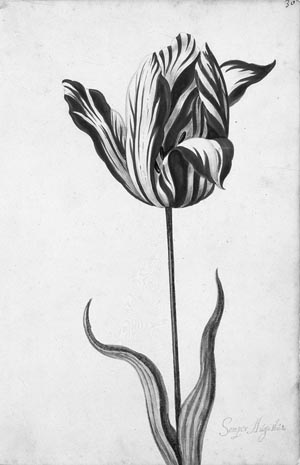Post by dodger on Sept 18, 2013 16:34:57 GMT
It was the world’s first financial bubble, and at the centre of it was a luxury flower and the world’s first futures market…
When 70 tulips sold for the price of 300 tons of butter
WORKERS, DECEMBER 2009 ISSUE
The Dutch were not the first to be crazed by the tulip: the flower had enchanted the Persians and bewitched the rulers of the Ottoman Empire. Tulips were different from every other flower known to horticulturists in the 17th century; their colours were more intense and more concentrated than those of ordinary plants.
The seeds of the Dutch tulip craze were planted in 1593 with the first import of a tulip bulb into Holland from Constantinople. Early 17th century Amsterdam merchants, at the centre of the lucrative East Indies trade, displayed their success by erecting grand estates surrounded by flower gardens. The tulip rapidly became a coveted luxury item, a status symbol and a novelty for the rich and famous. Initially, only the true connoisseurs bought tulip bulbs, but the rapidly rising price in the 1630s quickly attracted speculators looking to profit and a new type of tulip fancier appeared, lured by tales of fat profits. ''Florists,'' or professional tulip traders, sought out flower lovers and speculators alike.
By 1634, speculators began to enter the market and tulip mania had feverishly spread beyond the aristocrats and merchants. Pretty soon everybody was dealing in tulip bulbs, looking to make a quick fortune. The majority of the tulip bulb buyers had no intentions of even planting these bulbs! The name of the game was to buy low and sell high, just like in any other market. The tulip bulbs were traded on local market exchanges, which were not unlike today’s stock exchanges. The Dutch nation was caught in a sweeping mania, as people traded in their land, livestock, farms and life savings all to acquire one single tulip bulb!
The Dutch, who developed many of the techniques of modern capitalist finance, created a market for durable tulip bulbs. By 1636, any tulip could be sold off, often for hundreds of guilders, and the Dutch created a type of formal futures market where contracts to buy bulbs at the end of the season were bought and sold, traders meeting in "colleges" at taverns. No deliveries were ever made to fulfill these contracts because of the market collapse in February 1637.
Tulip mania reached its peak during the winter of 1636/37, when some bulbs were changing hands ten times in a day and where, at an auction, 70 fine tulips sold for nearly 53,000 guilders. By way of comparison, a ton of butter cost around 100 florins, a skilled labourer might earn 150 florins a year, and "eight fat swine" cost 240 florins (a guilder was worth about 60 per cent of a florin at this time).
Mad rush
At the peak of tulip mania in February 1637, tulip contracts sold for more than 10 times the annual income of a skilled craftsman. In less than one month, the price of tulip bulbs went up twenty-fold. At its height there was a mad rush to buy tulip bulbs at any cost.


Above: Tulip field, the Netherlands. Left 17th-century painting of the Semper Augustus, the most expensive tulip sold during tulip mania.
The crazed sections of the population imagined that the passion for tulips would last for ever, and that the wealthy from every part of the world would send to Holland, and pay whatever prices were asked for them. However, such a scheme could not last unless someone was ultimately willing to pay such high prices and take possession of the bulbs.
Soon after, in February 1637, the tulip market crashed spectacularly and panic spread across the country. The market for tulips evaporated. Flowers that had commanded 5,000 guilders a few weeks before now fetched 100; tulip traders could no longer find new buyers willing to pay increasingly inflated prices for their bulbs.
As this realisation set in, the demand for tulips collapsed, and prices plummeted—the speculative bubble burst. The mania finally ended, with individuals stuck with the bulbs they held at the end of the crash — no court would enforce payment of a contract, since the debts were regarded as contracted through gambling, and thus not enforceable by law.
The Tulip Mania of the 17th century is an account of incredible financial folly.
A whole network of values was thrown into doubt. In the 17th century, it was unimaginable to most people that something as common as a flower could be worth so much more money than most people earned in a year.
It is fashionable today for bourgeois economists to argue that the overall fall out on the Dutch economy was negligible, as against traditional views that the aftermath of the tulip price deflation led to a widespread economic chill throughout the Netherlands for many years afterwards. Interestingly, some economists also point to the role of a growth in the supply of money, as demonstrated by an increase in deposits at the Bank of Amsterdam during that period, being an important factor associated with a speculative bubble.
Tulip mania is not so different from the dot.com bubble of 1995–2001 or the recent sub prime mortgage crisis. Capitalism is an active breeding ground for financial speculation.
